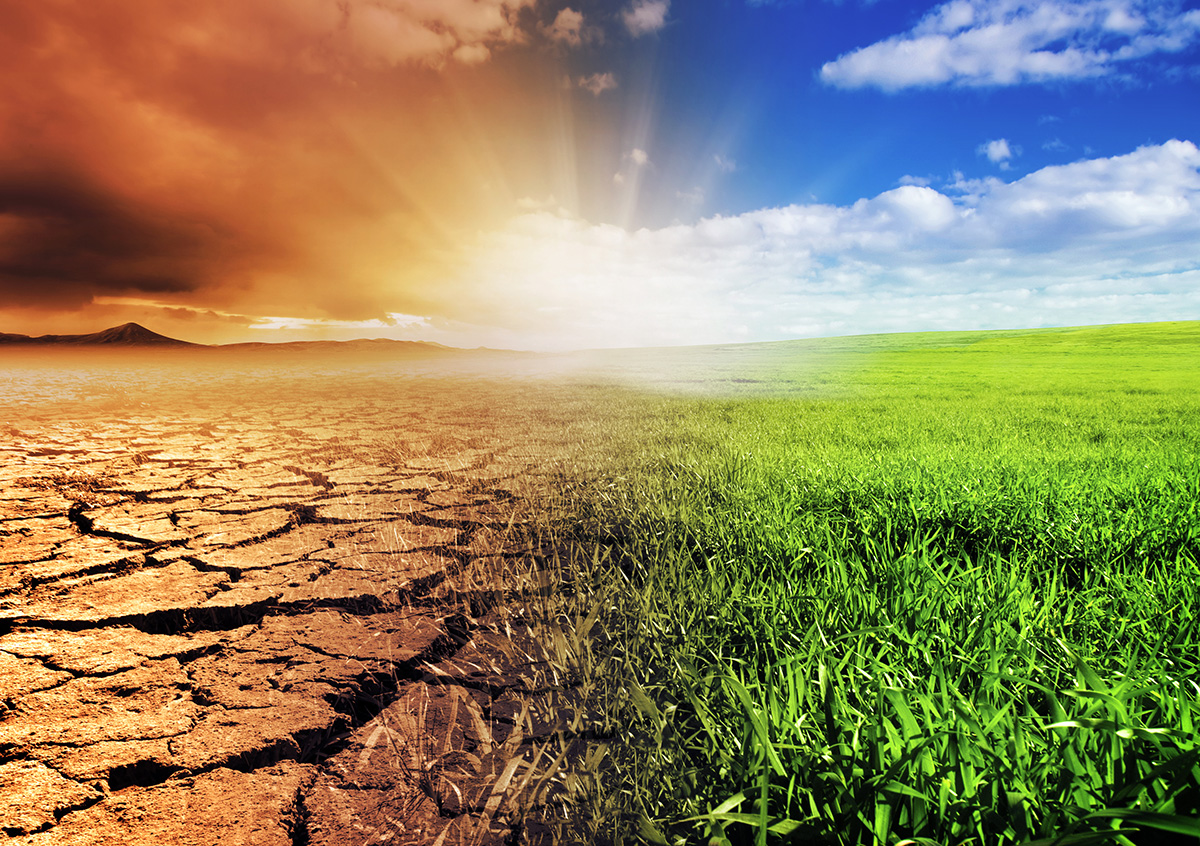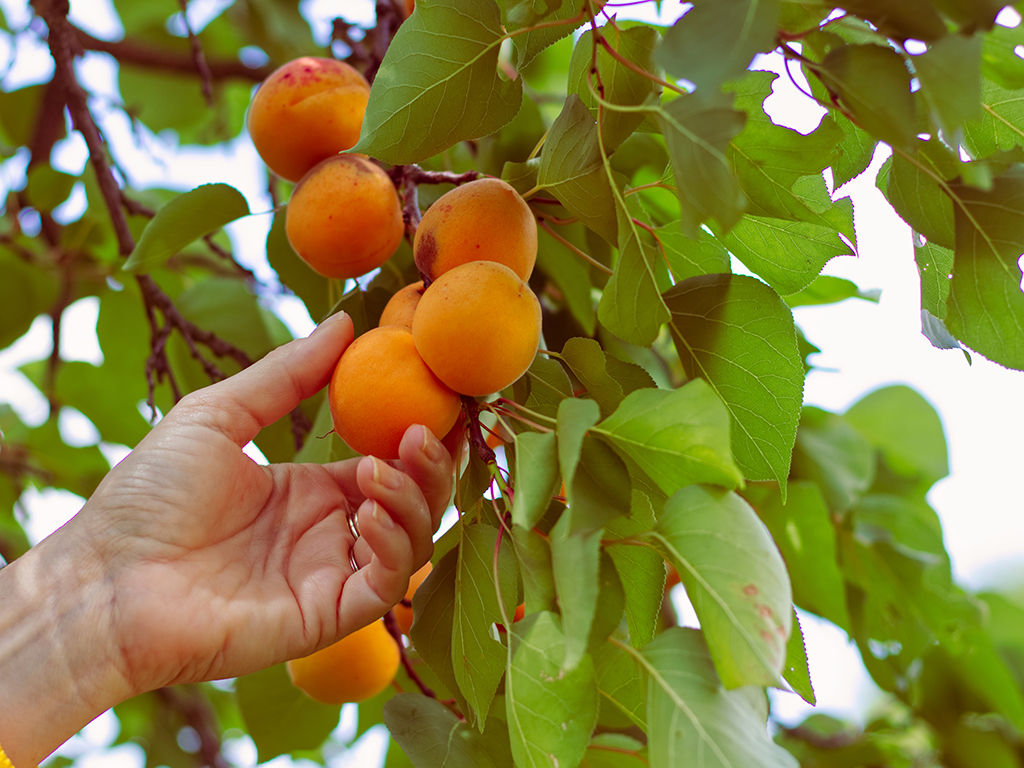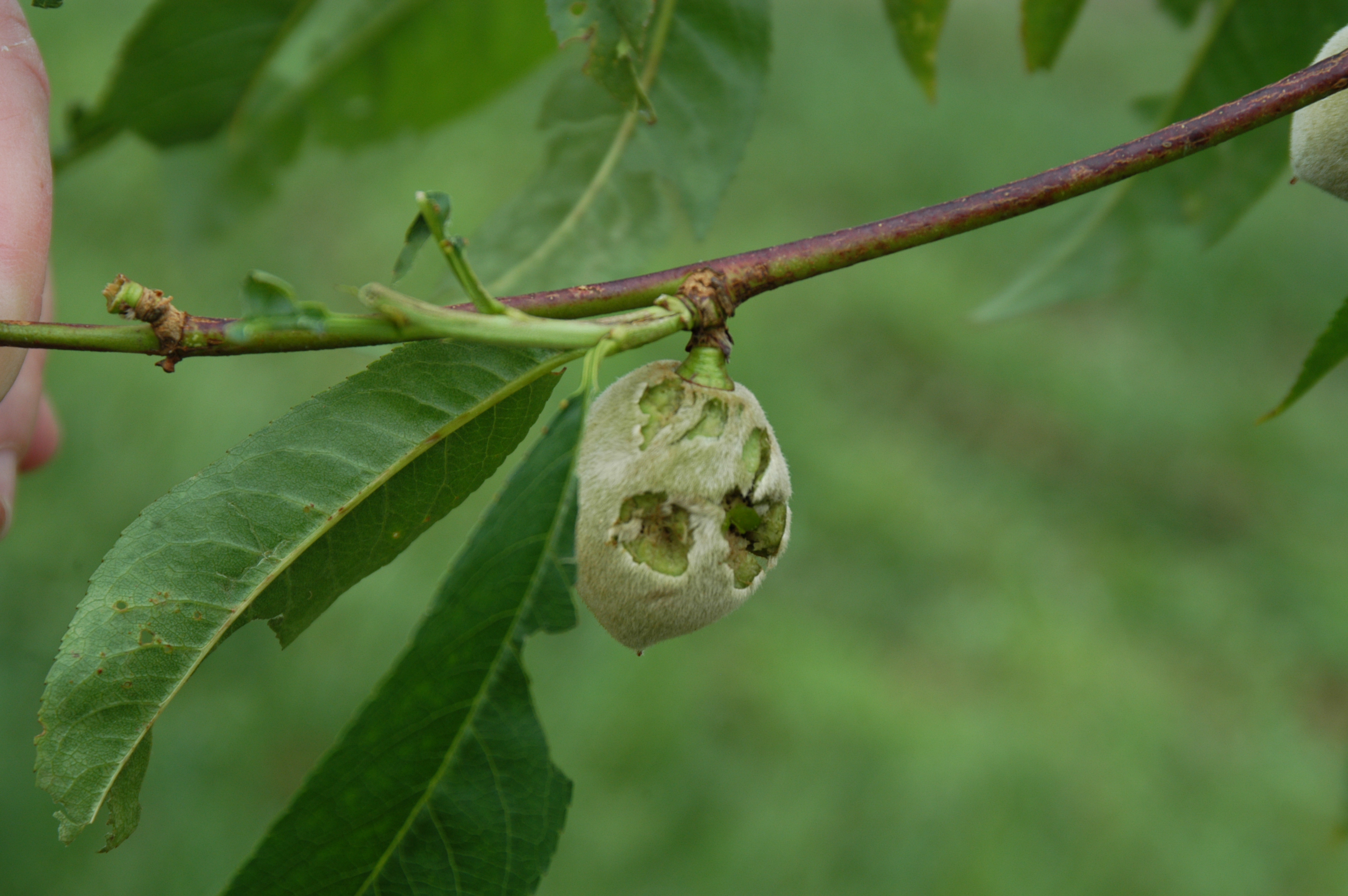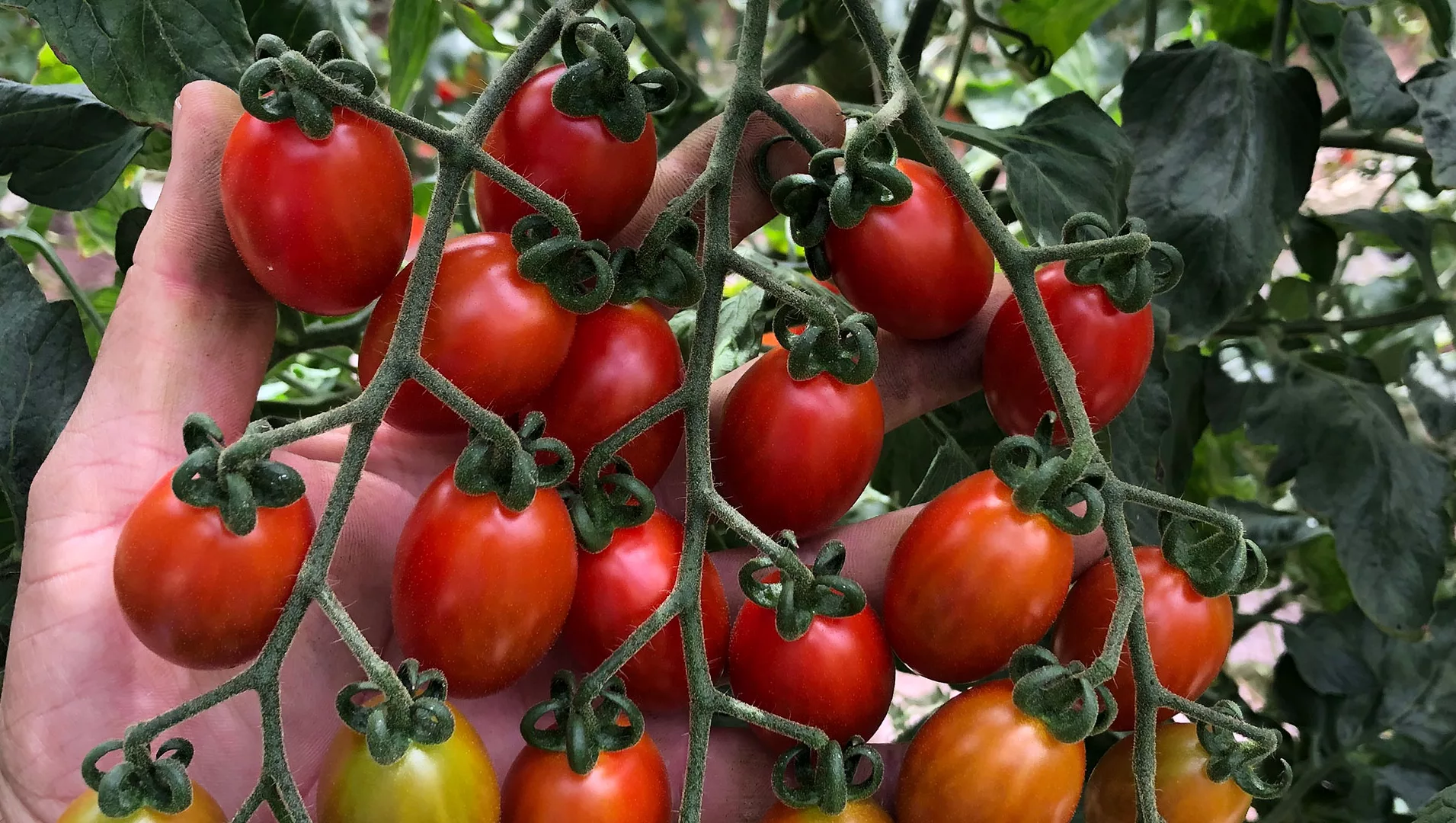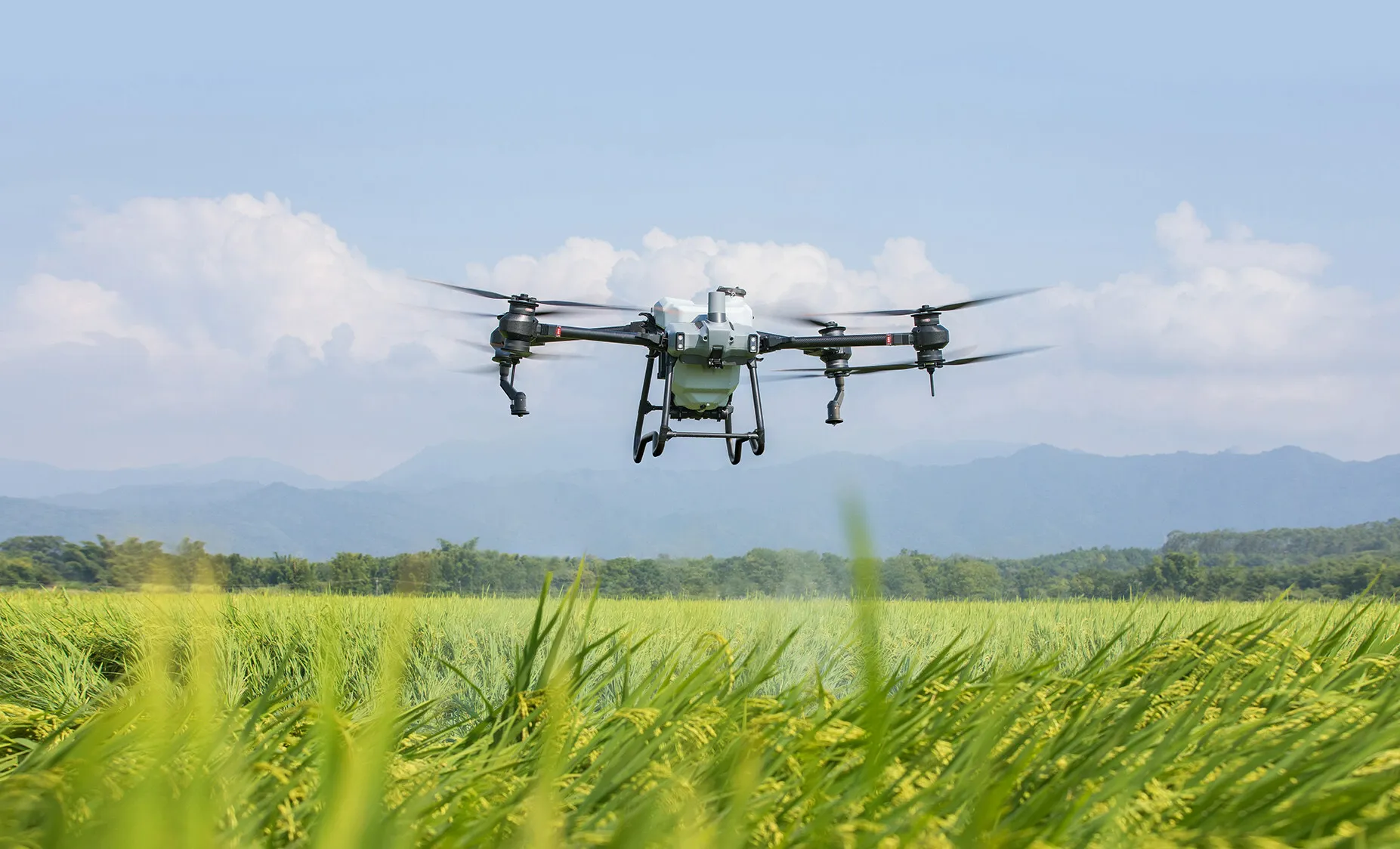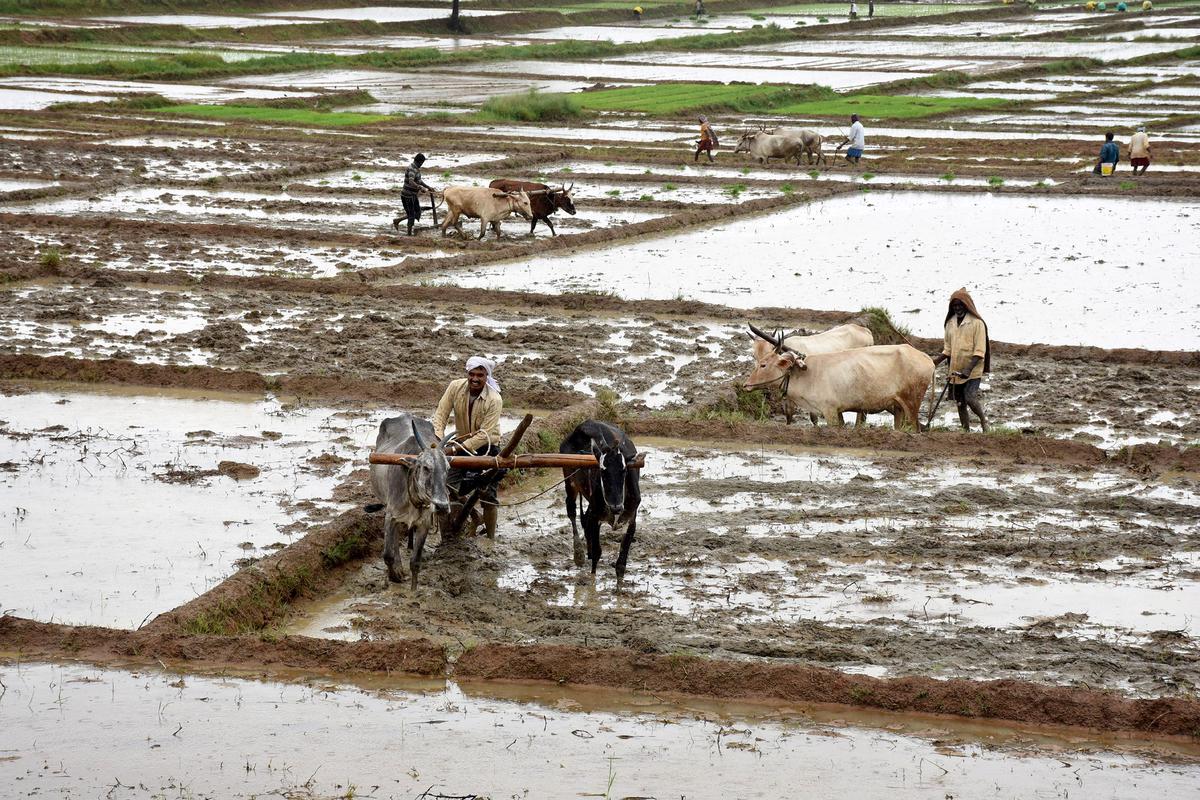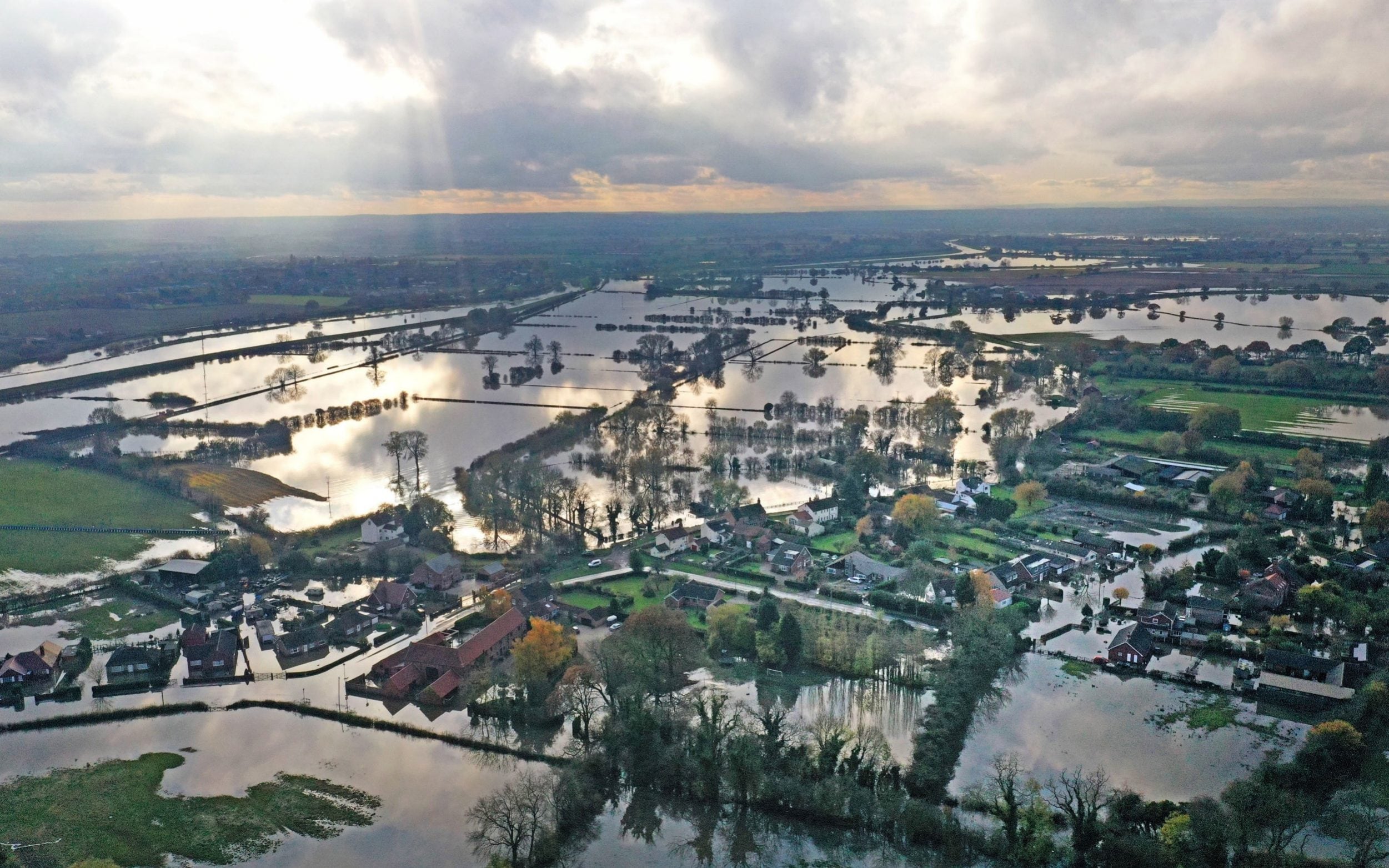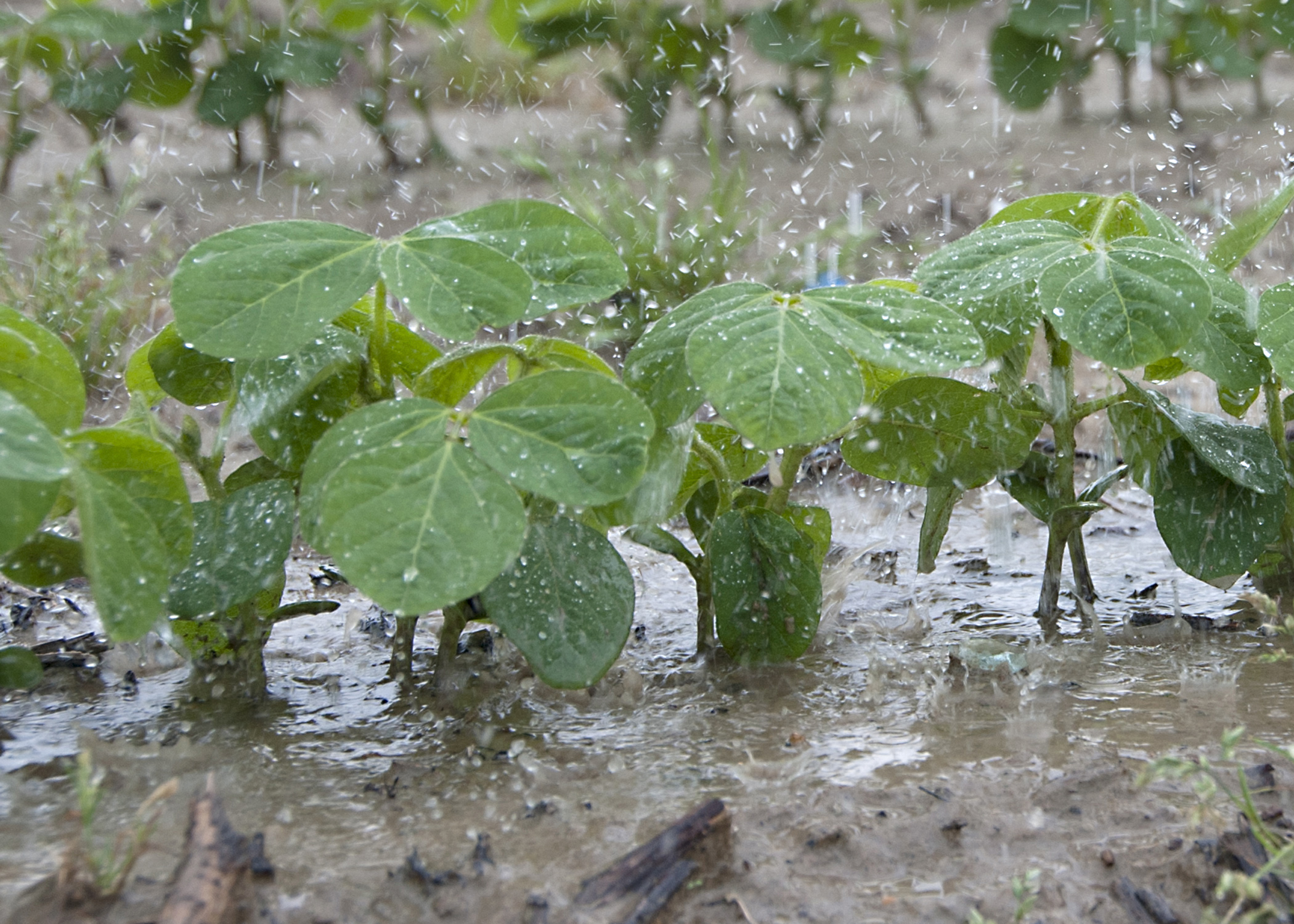Canada and other countries in the Arctic are expected to warm more than any other on Earth during the coming decades as a result of anthropogenic climate change. A series of computer model predictions published by Environment and Climate Change Canada anticipate that both temperature and precipitation will be considerably different than today, with some provinces experiencing those changes more than others. A different climate, however, can have both positive and negative impacts on agriculture, from individual plants to entire global networks.
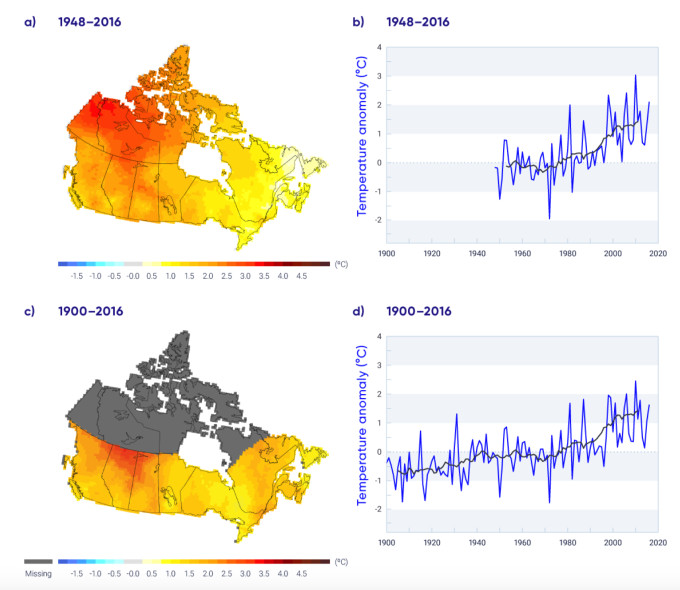 (Graphic: Observed changes (°C) in annual temperature between (a) 1948 and 2016 and (c) 1900 and 2016 relative to the mean for the period 1961–1990 (b) for Canada as a whole and (d) for southern Canada (south of 60° north latitude); the black lines are 11-year running means. Estimates are derived from the gridded station data. There are insufficient data in northern Canada to confidently calculate warming trends from 1900 to 2016. Source: Report by Environment and Climate Change Canada.)
(Graphic: Observed changes (°C) in annual temperature between (a) 1948 and 2016 and (c) 1900 and 2016 relative to the mean for the period 1961–1990 (b) for Canada as a whole and (d) for southern Canada (south of 60° north latitude); the black lines are 11-year running means. Estimates are derived from the gridded station data. There are insufficient data in northern Canada to confidently calculate warming trends from 1900 to 2016. Source: Report by Environment and Climate Change Canada.)
In some areas of Canada, where temperatures are so low, and the growing season so short, warming may provide new opportunities for agriculture as the growing season expands.
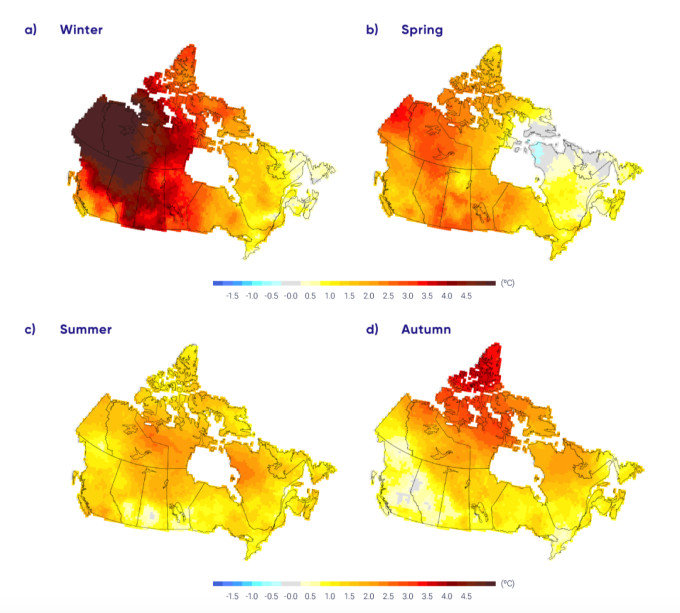 (Graphic: Observed changes (°C) in seasonal mean temperatures between 1948 and 2016 for the four seasons. Estimates are derived based on linear trends in the gridded station data. Source: Report by Environment and Climate Change Canada.)
(Graphic: Observed changes (°C) in seasonal mean temperatures between 1948 and 2016 for the four seasons. Estimates are derived based on linear trends in the gridded station data. Source: Report by Environment and Climate Change Canada.)
Canada’s climate has warmed and it will warm further in the future. Both the observed and projected increases in mean temperature in Canada are about twice the corresponding increases in the global mean temperature, regardless of the emission scenario. Annual and seasonal mean temperatures have increased, with the greatest warming occurring in winter. Between 1948 and 2016, the best estimate of the mean annual temperature increase is 1.7°C for Canada as a whole and 2.3°C for northern Canada.
While both human activity and natural variations in the climate have contributed to this observed warming, the human factor is most dominant. More than half of the observed warming in Canada is likely due to the influence of humans.
Annual and seasonal mean temperature is projected to increase everywhere, with much larger changes in northern Canada in winter. Averaged over the country, warming projected in a low emission scenario is about 2°C higher than the 1986–2005 reference period, remaining relatively steady after 2050, whereas in a high emission scenario, temperature increases will continue, reaching more than 6°C by the late 21st century.
Future warming will be accompanied by a longer growing season, fewer heating degree days, and more cooling degree days.
Extreme temperature changes, both in observations and future projections, are consistent with warming. Extreme warm temperatures have become hotter, while extreme cold temperatures have become less cold. Such changes are projected to continue in the future, with the magnitude of change proportional to the magnitude of mean temperature change.
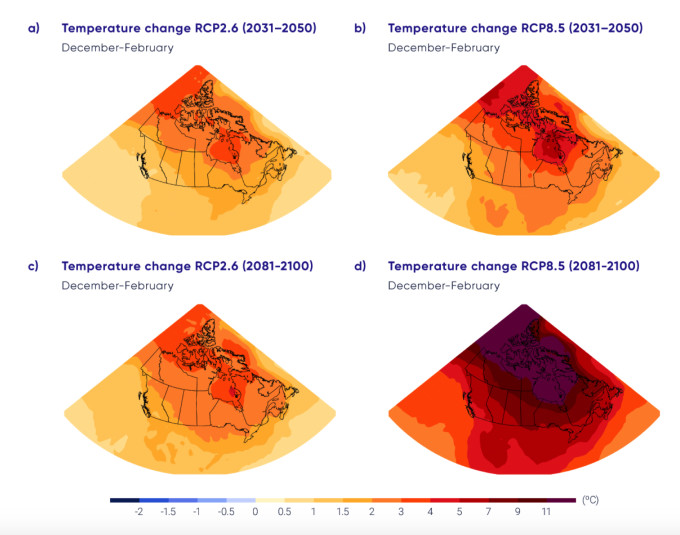 (Graphic: Maps and time series of projected temperature change (°C) for December, January, and February, as represented by the median of the CMIP5 multi-model ensemble. Changes are relative to the 1986–2005 period. The upper maps show temperature change for the 2031–2050 period and the lower maps, for the 2081–2100 period. The left-hand maps show changes resulting from the low emission scenario (RCP2.6), whereas the right- hand maps show changes from the high emission scenario (RCP8.5) Source: Report by Environment and Climate Change Canada.)
(Graphic: Maps and time series of projected temperature change (°C) for December, January, and February, as represented by the median of the CMIP5 multi-model ensemble. Changes are relative to the 1986–2005 period. The upper maps show temperature change for the 2031–2050 period and the lower maps, for the 2081–2100 period. The left-hand maps show changes resulting from the low emission scenario (RCP2.6), whereas the right- hand maps show changes from the high emission scenario (RCP8.5) Source: Report by Environment and Climate Change Canada.)
Experts also anticipate that climate change could improve soil quality by enhancing carbon sequestration and reducing the emissions of greenhouse gases by land-use changes. Annual crop production could be overtaken by perennial crops and grazing lands modifying the current carbon sinks.
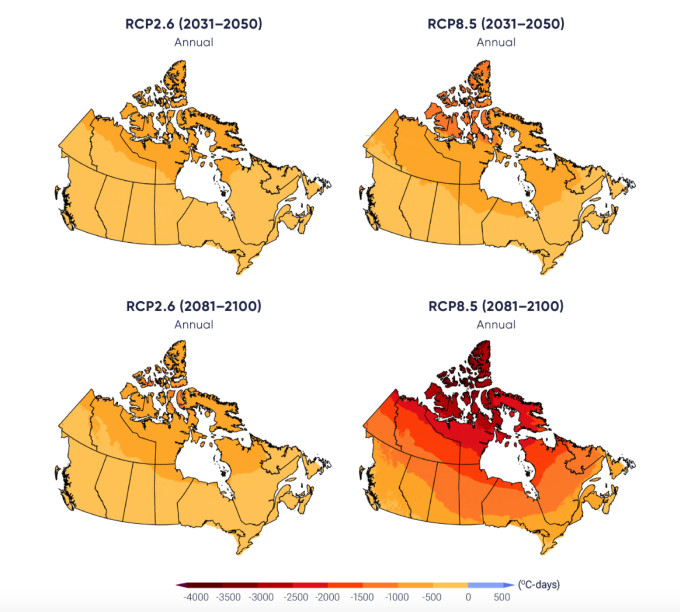 (Graphic: Projected change in freezing degree days (°C) for the period 2031–2050 (upper panels) and 2081–2100 (lower panels) relative to 1986–2005 average. Source: Report by Environment and Climate Change Canada.)
(Graphic: Projected change in freezing degree days (°C) for the period 2031–2050 (upper panels) and 2081–2100 (lower panels) relative to 1986–2005 average. Source: Report by Environment and Climate Change Canada.)
There is medium confidence that annual mean precipitation has increased, on average, in Canada, with larger percentage increases in northern Canada. Such increases are consistent with model simulations of anthropogenic climate change.
Model simulations show that annual and winter precipitation is projected to increase everywhere in Canada over the 21st century, with more pronounced changes in northern Canada.
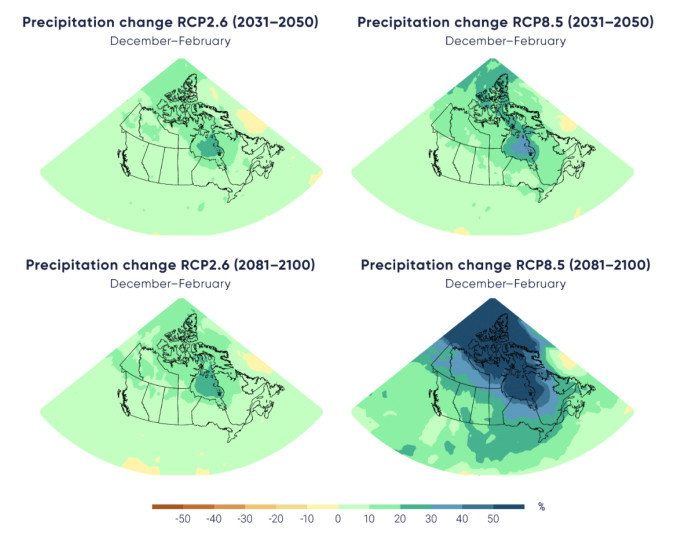 (Graphic: Maps and time series of projected precipitation change (%) for December, January, and February, as represented by the median of the fifth phase of the Coupled Model Intercomparison Project (CMIP5) multi-model ensemble. Changes are relative to the 1986–2005 period. Source: Report by Environment and Climate Change Canada.)
(Graphic: Maps and time series of projected precipitation change (%) for December, January, and February, as represented by the median of the fifth phase of the Coupled Model Intercomparison Project (CMIP5) multi-model ensemble. Changes are relative to the 1986–2005 period. Source: Report by Environment and Climate Change Canada.)
Summer precipitation is projected to decrease over southern Canada under a high emission scenario toward the end of the 21st century, but only small changes are projected under a low emission scenario.
For Canada as a whole, observational evidence of changes in extreme precipitation amounts, accumulated over periods of a day or less, is lacking. However, in the future, daily extreme precipitation is projected to increase.
Some of the main concerns for Canada's agriculture are climate change-related. The future climate could increase the intensity and frequency of droughts, while storms could become more violent and damaging. This would put a dent in crop yields, especially in semi-arid regions of Canada.
The 2001 and 2002 droughts to the floods of 2010 and 2011 brought devastation to many crops across the country, with a 50 percent reduction of the average yields.
Livestock could also suffer the consequences of climate change if warmer summers become the norm. Loss of livestock due to heat waves, especially in the poultry sector, reduced milk production and reduced reproduction in the dairy industry. Beyond pasture availability to feed the animals, a warmer environment could also lead to an increase in the prevalence of pests and pathogens in livestock and crops.
Source - https://www.theweathernetwork.com
 (Graphic: Observed changes (°C) in annual temperature between (a) 1948 and 2016 and (c) 1900 and 2016 relative to the mean for the period 1961–1990 (b) for Canada as a whole and (d) for southern Canada (south of 60° north latitude); the black lines are 11-year running means. Estimates are derived from the gridded station data. There are insufficient data in northern Canada to confidently calculate warming trends from 1900 to 2016. Source: Report by Environment and Climate Change Canada.)
In some areas of Canada, where temperatures are so low, and the growing season so short, warming may provide new opportunities for agriculture as the growing season expands.
(Graphic: Observed changes (°C) in annual temperature between (a) 1948 and 2016 and (c) 1900 and 2016 relative to the mean for the period 1961–1990 (b) for Canada as a whole and (d) for southern Canada (south of 60° north latitude); the black lines are 11-year running means. Estimates are derived from the gridded station data. There are insufficient data in northern Canada to confidently calculate warming trends from 1900 to 2016. Source: Report by Environment and Climate Change Canada.)
In some areas of Canada, where temperatures are so low, and the growing season so short, warming may provide new opportunities for agriculture as the growing season expands.
 (Graphic: Observed changes (°C) in seasonal mean temperatures between 1948 and 2016 for the four seasons. Estimates are derived based on linear trends in the gridded station data. Source: Report by Environment and Climate Change Canada.)
Canada’s climate has warmed and it will warm further in the future. Both the observed and projected increases in mean temperature in Canada are about twice the corresponding increases in the global mean temperature, regardless of the emission scenario. Annual and seasonal mean temperatures have increased, with the greatest warming occurring in winter. Between 1948 and 2016, the best estimate of the mean annual temperature increase is 1.7°C for Canada as a whole and 2.3°C for northern Canada.
While both human activity and natural variations in the climate have contributed to this observed warming, the human factor is most dominant. More than half of the observed warming in Canada is likely due to the influence of humans.
Annual and seasonal mean temperature is projected to increase everywhere, with much larger changes in northern Canada in winter. Averaged over the country, warming projected in a low emission scenario is about 2°C higher than the 1986–2005 reference period, remaining relatively steady after 2050, whereas in a high emission scenario, temperature increases will continue, reaching more than 6°C by the late 21st century.
Future warming will be accompanied by a longer growing season, fewer heating degree days, and more cooling degree days.
Extreme temperature changes, both in observations and future projections, are consistent with warming. Extreme warm temperatures have become hotter, while extreme cold temperatures have become less cold. Such changes are projected to continue in the future, with the magnitude of change proportional to the magnitude of mean temperature change.
(Graphic: Observed changes (°C) in seasonal mean temperatures between 1948 and 2016 for the four seasons. Estimates are derived based on linear trends in the gridded station data. Source: Report by Environment and Climate Change Canada.)
Canada’s climate has warmed and it will warm further in the future. Both the observed and projected increases in mean temperature in Canada are about twice the corresponding increases in the global mean temperature, regardless of the emission scenario. Annual and seasonal mean temperatures have increased, with the greatest warming occurring in winter. Between 1948 and 2016, the best estimate of the mean annual temperature increase is 1.7°C for Canada as a whole and 2.3°C for northern Canada.
While both human activity and natural variations in the climate have contributed to this observed warming, the human factor is most dominant. More than half of the observed warming in Canada is likely due to the influence of humans.
Annual and seasonal mean temperature is projected to increase everywhere, with much larger changes in northern Canada in winter. Averaged over the country, warming projected in a low emission scenario is about 2°C higher than the 1986–2005 reference period, remaining relatively steady after 2050, whereas in a high emission scenario, temperature increases will continue, reaching more than 6°C by the late 21st century.
Future warming will be accompanied by a longer growing season, fewer heating degree days, and more cooling degree days.
Extreme temperature changes, both in observations and future projections, are consistent with warming. Extreme warm temperatures have become hotter, while extreme cold temperatures have become less cold. Such changes are projected to continue in the future, with the magnitude of change proportional to the magnitude of mean temperature change.
 (Graphic: Maps and time series of projected temperature change (°C) for December, January, and February, as represented by the median of the CMIP5 multi-model ensemble. Changes are relative to the 1986–2005 period. The upper maps show temperature change for the 2031–2050 period and the lower maps, for the 2081–2100 period. The left-hand maps show changes resulting from the low emission scenario (RCP2.6), whereas the right- hand maps show changes from the high emission scenario (RCP8.5) Source: Report by Environment and Climate Change Canada.)
Experts also anticipate that climate change could improve soil quality by enhancing carbon sequestration and reducing the emissions of greenhouse gases by land-use changes. Annual crop production could be overtaken by perennial crops and grazing lands modifying the current carbon sinks.
(Graphic: Maps and time series of projected temperature change (°C) for December, January, and February, as represented by the median of the CMIP5 multi-model ensemble. Changes are relative to the 1986–2005 period. The upper maps show temperature change for the 2031–2050 period and the lower maps, for the 2081–2100 period. The left-hand maps show changes resulting from the low emission scenario (RCP2.6), whereas the right- hand maps show changes from the high emission scenario (RCP8.5) Source: Report by Environment and Climate Change Canada.)
Experts also anticipate that climate change could improve soil quality by enhancing carbon sequestration and reducing the emissions of greenhouse gases by land-use changes. Annual crop production could be overtaken by perennial crops and grazing lands modifying the current carbon sinks.
 (Graphic: Projected change in freezing degree days (°C) for the period 2031–2050 (upper panels) and 2081–2100 (lower panels) relative to 1986–2005 average. Source: Report by Environment and Climate Change Canada.)
There is medium confidence that annual mean precipitation has increased, on average, in Canada, with larger percentage increases in northern Canada. Such increases are consistent with model simulations of anthropogenic climate change.
Model simulations show that annual and winter precipitation is projected to increase everywhere in Canada over the 21st century, with more pronounced changes in northern Canada.
(Graphic: Projected change in freezing degree days (°C) for the period 2031–2050 (upper panels) and 2081–2100 (lower panels) relative to 1986–2005 average. Source: Report by Environment and Climate Change Canada.)
There is medium confidence that annual mean precipitation has increased, on average, in Canada, with larger percentage increases in northern Canada. Such increases are consistent with model simulations of anthropogenic climate change.
Model simulations show that annual and winter precipitation is projected to increase everywhere in Canada over the 21st century, with more pronounced changes in northern Canada.
 (Graphic: Maps and time series of projected precipitation change (%) for December, January, and February, as represented by the median of the fifth phase of the Coupled Model Intercomparison Project (CMIP5) multi-model ensemble. Changes are relative to the 1986–2005 period. Source: Report by Environment and Climate Change Canada.)
Summer precipitation is projected to decrease over southern Canada under a high emission scenario toward the end of the 21st century, but only small changes are projected under a low emission scenario.
For Canada as a whole, observational evidence of changes in extreme precipitation amounts, accumulated over periods of a day or less, is lacking. However, in the future, daily extreme precipitation is projected to increase.
Some of the main concerns for Canada's agriculture are climate change-related. The future climate could increase the intensity and frequency of droughts, while storms could become more violent and damaging. This would put a dent in crop yields, especially in semi-arid regions of Canada.
The 2001 and 2002 droughts to the floods of 2010 and 2011 brought devastation to many crops across the country, with a 50 percent reduction of the average yields.
Livestock could also suffer the consequences of climate change if warmer summers become the norm. Loss of livestock due to heat waves, especially in the poultry sector, reduced milk production and reduced reproduction in the dairy industry. Beyond pasture availability to feed the animals, a warmer environment could also lead to an increase in the prevalence of pests and pathogens in livestock and crops.
Source - https://www.theweathernetwork.com
(Graphic: Maps and time series of projected precipitation change (%) for December, January, and February, as represented by the median of the fifth phase of the Coupled Model Intercomparison Project (CMIP5) multi-model ensemble. Changes are relative to the 1986–2005 period. Source: Report by Environment and Climate Change Canada.)
Summer precipitation is projected to decrease over southern Canada under a high emission scenario toward the end of the 21st century, but only small changes are projected under a low emission scenario.
For Canada as a whole, observational evidence of changes in extreme precipitation amounts, accumulated over periods of a day or less, is lacking. However, in the future, daily extreme precipitation is projected to increase.
Some of the main concerns for Canada's agriculture are climate change-related. The future climate could increase the intensity and frequency of droughts, while storms could become more violent and damaging. This would put a dent in crop yields, especially in semi-arid regions of Canada.
The 2001 and 2002 droughts to the floods of 2010 and 2011 brought devastation to many crops across the country, with a 50 percent reduction of the average yields.
Livestock could also suffer the consequences of climate change if warmer summers become the norm. Loss of livestock due to heat waves, especially in the poultry sector, reduced milk production and reduced reproduction in the dairy industry. Beyond pasture availability to feed the animals, a warmer environment could also lead to an increase in the prevalence of pests and pathogens in livestock and crops.
Source - https://www.theweathernetwork.com


